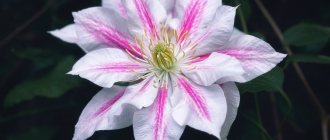Sofya Slavyanskaya Grows bush tulips
Multi-flowered tulips are a special type of plant that form a whole bouquet from one bulb. These tulips are not suitable for cutting, but look great on a club. They are found among terry, fringed and Triumph class. Let's take a closer look at popular varieties with names and photos.
The flowers that grow from the apical bud are larger than the others. The bushes will look better in group plantings. Photo: vasha-usadba.com
Features of growing multi-flowered tulips
Bulbs of multi-flowered tulips are easy to purchase, but these plants are not easy to grow. Only hardworking, careful gardeners can obtain planting material that will again produce several flowers next year and grow a lush bush from it.
What conditions will help to grow bush tulips:
- selection of high-quality planting material – first selection and “extra”, bulbs – at least 4 centimeters;
- regular watering;
- fertilizing 3 times per season;
- digging annually - during the hot period, the bulbs are removed from the ground.
Often only the flower from the apical bud has good external characteristics; the rest lag behind it in terms of flowering and are inferior in size and brightness.
Advice: it is better to plant bush tulips in groups, so they look more impressive and expressive.
How to plant tulips in autumn?
Experienced flower growers know that autumn is the most important period in the life of all tulips, including multi-flowered ones. Although they are perennials, tulip bulbs should be replanted every year. This minimizes the risk of developing various diseases and stimulates the formation of healthy flower stalks.
How to plant tulips in autumn? This question interests beginners in floriculture. This work is carried out in the second half of September or early October. For planting, it is necessary to choose a well-lit place with low groundwater, since the bulbs may die if they are over-moistened.
Tulips need loose and light soil, with an alkaline neutral structure, since these plants do not tolerate acidic soils. Before planting, you need to prepare the bulbs. They should be kept for about an hour in a suspension of Topsin-M or Zineb. The solution is prepared at the rate of fifty grams of product per bucket of water.
Tulip multiflora should be planted at a depth that is two to three times the height of the bulb. As a rule, this is ten to twenty centimeters. The planting material must be carefully pressed at the bottom of the furrows into the loose soil, but under no circumstances screwed in. You should handle the bulb especially carefully in October. During this period, the root roll swells and becomes fragile and vulnerable to damage.
For central Russia, the most suitable time for planting tulips is the second half of September. The temperature at this time is still quite high, there are many sunny days. Rooting of the plant begins at the moment when the temperature at the depth of the bulbs drops to +4-9 degrees Celsius. In dry autumn, after planting, the beds must be watered abundantly. To keep the soil warm for as long as possible and to maximize the rooting time of the bulbs, which is especially important for late planting, the ridges must be sprinkled with peat.
Varieties of class
Work on breeding tulips with a large number of flowers began in the 40s of the 20th century. Today, about 3 dozen bush varieties are known.
Antoinette
The variety belongs to chameleons. The flowers bloom are pale yellow, with a white edge that gradually turns pink. There are up to 4-6 flowers on a plant. The height of the bush is 45 centimeters.
Like most tulips, they bloom in May. They easily endure the vagaries of spring weather - wind and lack of sun.
Candy Kisses
Gives magnificent flowers of the most delicate color - pink with a peach tint along the edge. The number of buds is 3-6. If desired, it can be grown as a potted crop. Flowering - early May.
Quebec
A low variety (30-35 centimeters), which will well decorate the edge of a flower bed with early flowering. The bush has 3 orange flowers with a yellow border.
Rosie Bouquet
This plant really blooms in a bouquet - beautiful multi-petaled flowers have a creamy color and an intricate pink border around the edge. Gives up to 6 colors. Height – 50-55 centimeters.
Belicia
April chooses the Belicia variety to bloom. The flowers are lush, with yellowish-white petals, along the edge of which there is a scarlet-lilac stripe. Decorative large flowers on stems up to 50 centimeters.
Friendly Family
The Fringed Family bush tulip is rightfully considered one of the most beautiful among its fellows - the flowers are bright and delicate at the same time. A thin white carved border surrounds the pink-purple petals. Bouquet – 5-7 flowers. Flowering – April-May.
Wallflower
Exquisite long (up to 8 centimeters) tulips in dark burgundy color. The plant produces 5 buds that look together like a real bouquet. Wallflower blooms for a long time - 10-15 days.
Orange Bouquet
The bouquet variety produces buds of a distinct orange hue. The inside of the flower is pink. Orange Bouquet is good in flower beds and used to decorate the area. Blooms in April-May with 3-5 buds.
See also
When and how to properly plant tulips in bulb baskets with your own handsRead
Fleming Club
Bright variegated flowers in white and pink shades are produced by this bushy appearance. The stripes along the petals give the tulip a festive look. With good care and planting material, the number of flowers is up to 11. Suitable for bouquets and decorating flower beds.
Night Club
Very beautiful single-color tulips with a distinct lilac-pink color. They look good next to plain white or yellow tulips. Night Club produces up to 7 flowers, good in a bouquet and in a flower bed. Blooms in May.
Gypsy Love
The exquisite purple-red hue and fringe along the edges of the petals are the main features of Gipsy Love. The flowers are large - up to 10 centimeters. Despite the long flowering period (up to 3 weeks), they keep their shape well - they do not open up and do not lose color. Stable, like real gypsies, Gipsy Love is “gypsy love.”
Red Georgette
Bright garnet-colored flowers, up to 7 centimeters tall. The long stem (50-60 centimeters) allows you to beautifully assemble them into a bouquet. Red Georgette produces up to 5 flowers, which are convenient to plant in beds with other single-color tulips.
Multi-flowering simple early
In the photo: Duke van Tol
These tulips have been known since the 17th century, and their common ancestor is the European variety Duc van Tol. They are distinguished by a thick stem and a large flower, shaped like a glass, which can be painted in rich bright colors (pink, orange, red). There are also white varieties. They are grown in flowerbeds and in decorative pots, but due to their short stems they are usually not used in bouquets.
The most common variety in this group is the two-color “Princess Irene”, which has orange-red petals with a burgundy edge. These flowers look great both in a flower bed and in bouquets in combination with forget-me-nots.
The pink-purple variety “Candy Prince”, considered one of the most delicate, is also in demand among gardeners. "White Prince" impresses with snow-white petals with slightly pointed edges.
Landing Features
Bush tulips need good care, which starts with proper planting. The soil should be loose, absorb moisture well and not harden into a crust.
When to plant tulips
The usual planting date is September, but flower growers recommend paying more attention to the weather. To prevent the plant from growing, the soil temperature should not be higher than 10-12 °.
Important: when planting in spring, the bulbs begin to be grown in a pot and transferred to the soil when it warms up to 15°. In this case, you should not count on full flowering.
Preparing the bulbs
The purchased planting material does not require preparation. Own bulbs are sorted, doubtful ones are discarded, and the peeling skin is removed. Before planting, immerse in a solution of potassium permanganate for 20-30 minutes and dry.
After flowering
If the tulip is not cut, after flowering, the remains of the ovary are carefully removed, leaving the stem. Wait for the green part of the plant to dry, after which the bulbs are dug up. This is done with bush tulips every year. The bulbs are sorted, sorted, and dried for about a week.
For a month, the bulbs are stored at temperatures above 30 °, then transferred to rooms with a lower temperature (20-22 °). At the time of planting, the bulbs should be stored at temperatures close to 15°.
Selecting a location
Tulips grow well in sunny and slightly shaded areas that receive direct sunlight part of the day. The area should be well protected from the wind, but dry, without long standing puddles.
All bulbous plants love light soils, but bush tulips are in dire need of them. Before planting, the soil is dug up to a depth of 30-35 centimeters, loosened well, and freed from roots and weeds. Drainage is laid, organic fertilizers and sand are added. Fertilize with organic matter 2-3 weeks before planting the bulbs.
Planting scheme
When planting multi-flowered tulips, adhere to the following rules:
- the distance between the bulbs is 10-15 centimeters;
- distance between rows – 20-25 centimeters;
- depth – 10-12 centimeters, for small bulbs – 5-8.
In winter, the area should be mulched with peat to protect it from freezing.
Tulip fields in the Netherlands
Holland is a real country of tulips. They were brought here at the end of the 16th century, which became the starting point of the tulip boom. People were willing to pay a fortune for flowers that were exotic at that time. Some people got rich from them, others went broke. Since the 80s In the 20th century, tulips in Holland were grown on an industrial scale, which made this country their main exporter to the world.
Colorful fields of these flowers can be admired in almost every corner of the country. But the most beautiful of them are located in Lisse, where the extensive Keukenhof flower park is located. The most talented flower growers and landscape designers work here to create original flower beds. A walk along the alleys of the park will allow you to get an unforgettable aesthetic pleasure while admiring the amazing tulip compositions.
Beautiful tulip fields in Holland are also located near the coastal cities of the North Sea. You can also visit the tulip fields of regular geometric shapes located in a drained reservoir near Amsterdam, which is often called the city of tulips.
At the end of April, the capital of the Netherlands hosts a colorful tulip festival, where you can buy rare varieties of bulbs. It is also possible to admire these flowers in the Leiden Botanical Garden and in the fields in the surrounding area.
Basic care rules
Only careful care will allow the plant to throw out several buds and bring them to flowering.
See also
When and how to plant tulips in different regions, timingRead
Watering and fertilizing
Bush beauties, unlike their lonely relatives, need constant hydration. Lack of moisture is one of the reasons why they don't produce many flowers the second year. The bulbs do not have enough strength to force and preserve buds. The earthen ball must be consistently moist.
Feeding three times a season is another condition for the release of buds and flowering. How to do it:
- for melting snow - mineral fertilizers - 40 grams per square meter;
- when buds appear - before watering in the same amount;
- at the beginning of flowering - a tablespoon of potassium dihydrogen phosphate per bucket of water (3-4 liters per square meter).
To get the number of flowers promised by the breeders, you cannot do without feeding.
Loosening the soil
Bulbs need good drainage and oxygen supply. Loosen the soil around the tulips after each rain and watering, preventing the formation of a crust. In order for the bulbs to master the formation and cultivation of a large number of buds, they are provided with comfort and care.
Weeding tulips
Tulips have sparse foliage and are clogged by weeds. Weeds are removed immediately after they appear during loosening. Otherwise, the weeds will draw moisture and nutrients from the bulb. It is better not to use chemicals against weeds; mechanical loosening is sufficient.
Transplanting tulips
The bulbs are dug up annually, making sure to ensure the recommended conditions outside the soil.
Multi-flowered tulips are transplanted to another place after 2-3 years.
Tulip propagation
When propagating tulips, daughter bulbs formed on the main one are used. Propagating bush tulips yourself and getting a multi-flowered plant is an impossible task for a simple gardener.
Green flowers
Distinguished by a greenish tint at the base of the petals, the variety was bred by geneticists from wild tulips crossed with various other species of these flowers. Experiments to achieve the original greenish color are still ongoing. The buds can be of different colors and shapes, but invariably all of them have a green or light green tint on the petals.
The Spring Green variety is popular. Large group plantings of the Artist variety look beautiful in flower beds. The most extravagant of this group is Violet Bird, which combines bright green and dark purple colors. It looks best next to white daffodils and pink forget-me-nots.
Diseases and pests of tulips
Excess moisture, poor soil drainage, and pests can cause damage to the bulbs, roots and green parts of plants.
The most common and dangerous diseases are different types of rot - fusarium, gray, botrytial, white. These fungal infections affect the bulbs and roots and spread to the leaves and buds. The disease appears from contaminated soil and bulbs.
Diseased plants need to be isolated and destroyed, the soil should be treated with fungicides and not used for up to 5 years.
Other types of diseases:
- aphid;
- rodents;
- mole cricket;
- slugs;
- purple owl.
To avoid pests, plants are inspected and treated against infection with insecticides.
Bulbs are stored in well-ventilated areas with humidity up to 60%, since planting material often becomes diseased if stored improperly.
What are bush tulips
Multicolor , bush , bouquet or multi-stem - these names describe the feature of a sufficient number of species of bulbous plants to produce several branches, side shoots and buds simultaneously from one seed bulb. Today there are descriptions of about 30 varieties of the non-trivial tulip flower.
In the 11th century, the tulip became a cultural symbol of the Seljuk Turks, and in the Ottoman Empire it was considered a symbol of renewal, peace and tranquility.
Problems in growing
Bush varieties are difficult to grow. The main sadness of amateur flower growers is that it is rarely possible to reproduce repeated flowering with a large bouquet from your own bulbs. Breeders are interested in the annual sale of seed material, and do not bother themselves with securing the properties of long-term multi-flowering.
But even good purchased bulbs will bloom with several buds only with proper care. You won’t be able to plant a tulip and just wait. Let us recall the necessary points of care:
- well-drained light soil;
- timely watering, constant soil moisture;
- loosening, easy access of air to the roots without drying out;
- three times feeding.
If a summer resident dreams of getting flowers from his own bulbs next year, he needs to follow all the rules for harvesting, storing and planting them.
Bush tulips look good in flower beds, but are inferior in beauty to their single counterparts when cut. To get a full-fledged bouquet, they need to be planted in winter, carefully observing all growing conditions. Early flowering, beautiful greenery and a magnificent multi-flowered bush will truly decorate the area.
Blue tulips: a pipe dream
Unfortunately, it is not possible to use blue flowers of this genus in landscape design. The thing is that the chromosomes of flowers lack the blue pigment gene!
However, purple tulips can be planted in the area, just like purple roses. Flowers with petals of this shade are considered one of the most beautiful and unusual, and in certain lighting they look blue.
Preparing a place for tulips
- Tulips love sunlight. Therefore, it is worth choosing well-lit places for them.
- The soil must be well worked and fertilized. It is worth starting its preparation several years in advance, since flowers do not tolerate fresh organic fertilizers.
- Immediately before planting, you can only add compost and humus.
It is not recommended to place tulips in the place of other bulbous plants. Once every 5 years, the place of growth should be changed.
- Tulips do not like excessive moisture. The soil should be slightly alkaline and nutritious.
Loams and sandstones are suitable. The area should be well heated, protected from drafts and stagnant water.
Shrubs growing nearby can provide good protection from the wind. At the same time, they should be positioned so that the tulips have enough light. Later varieties tolerate light darkening more easily.
About a month before planting flowers, the soil begins to be carefully prepared.
Required:
- dig up the ground well and remove all the weed roots from it;
- fertilize with humus or compost with the addition of wood ash and mineral additives;
- if necessary, install a high drainage layer.
To increase the beneficial properties of the soil, you can add superphosphate and phosphorus-potassium additives. Before planting, the soil is fertilized with nitrogen-containing substances.











